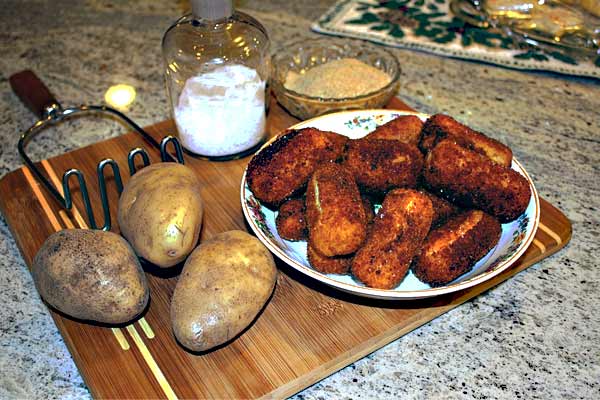 Croquettes first appeared on English dinner tables in the 18th century. In the mid-1800s, Americans knew croquet as a lawn game. The food version didn’t become widely popular in the States until the late 1870s, twenty years after recipes for croquettes began to be published.
Croquettes first appeared on English dinner tables in the 18th century. In the mid-1800s, Americans knew croquet as a lawn game. The food version didn’t become widely popular in the States until the late 1870s, twenty years after recipes for croquettes began to be published.
Not unlike pie, croquettes were a thrifty way to use leftovers and extend one’s meals. When croquettes gained popularity, the most common types were chicken and sweetbreads for main dishes, and potato for breakfast. The croquettes were generally shaped in cones or cylinders, but they could also be flattened.
A Denver newspaper reported how a housewife mastered the art of frugality with her croquettes. She served them to friend Isabel Gordon Curtis, who was astounded at how good they were. In 1898, she wrote a story about the visit and how her hostess had served her croquettes, but she could not detect the flavor. She asked, “I know it is not quite the proper thing to ask, but might I know how these croquettes are made?”
The hostess smiled and said, “These are poverty croquettes.”
“Poverty croquettes? Somehow that doesn’t seem to be quite the right sort of a name for them; they are quite the best I ever ate,” Curtis replied.
The hostess deferred to her husband to explain. He told their guest, “I eat this sort of thing about once a week and I’ve got to confess I like them.…Yet I dread horribly to watch them made. I don’t believe I could eat them if I were to see the things that go into them.”
The hostess went on to say that she saved all the meat scraps from a week’s worth of dinners to make her croquettes. She used a table sausage grinder to make the filling.
Curtis was stunned, but then again, who was she to question some of the best croquettes she had ever eaten?
Making croquettes did, and still does, require some patience to craft them perfectly according to Victorian standards. The Bismarck Daily Tribune noted something to that effect in an 1888 article titled, “How to Keep a Husband.” The story began, “I tell you, winning a husband is only a pleasure to a woman, but keeping him is a penance….Conscious of her abilities and inabilities as a wife, a wise woman will learn how to keep a husband just as she learns how to keep house, to make chicken croquettes, chocolate creams, bread…and if she doesn’t, why some syren [sic], with the sunshine in her tresses and the perfume of wild olives about her will secure for her a permanent vacation. ”
Home cooks and chefs began experimenting with croquettes. As the turn of the 20th century neared, recipes for rice, veal, lobster, turnip, plum pudding and even ice cream croquettes became popular.
Potato croquettes are some of the easiest types to make, so try your hand at the “husband-keeping” recipe.
*** R E C I P E ***
~Potato Croquettes~
4 medium potatoes, peeled and boiled
1 oz. butter
Pinch salt, nutmeg and sugar
1 egg
3 eggs, beaten in a separate bowl
Bread crumbs
Salt for sprinkling
. oil and . butter
Mash the potatoes and add the butter, salt, nutmeg, sugar and one egg.
Mix well, but do not overbeat. Chill for one hour. When cool, shape into cylinders or balls and then dip in eggs.
Next, dip in bread crumbs. Melt the oil and butter in a deep cook pot over medium high heat.
Gently place the croquettes into the oil and fry until golden.
Drain on a paper towel and season with salt.
***
Recipe adapted from The Republic
in St. Louis, Missouri, March 23, 1896
Sherry Monahan has penned Mrs. Earp: Wives & Lovers of the Earp Brothers; California Vines, Wines & Pioneers; Taste of Tombstone; The Wicked West and Tombstone’s Treasure. She’s appeared on the History Channel in Lost Worlds and other shows.






